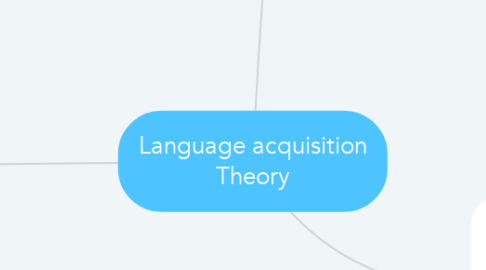
1. Cognitive: language is biologically predetermined mental ability
1.1. Chomsky's theory: Believes there's a part of the brain that is known for it's abilities to learn languages. Also believes that the same general cognitive skills used for everyday life is also used to learn new languages.
1.1.1. Analyzation is one aspect of this theory. For instance, students will be given a passage and will have to use their cognitive abilities to analyze different patterns.
1.1.1.1. Language element: Pragmatic. Pragmatic is the study of language through the point of view of the user (the student). In a classroom setting, students can analyze different text and passages in order to find different patterns that could be related to language.
1.1.2. Predetermined ability is another aspect. The ability to analyze patterns also ties into our abilities given at birth.
2. Behaviorism: Positive and negative reinforcement until the desired behavior is reached. Use of rewards and punishments to get to the desired behavior. Teaching through practice, repetition, and rewards
2.1. Skinners Theory: Known for connecting Pavlov's (Conditioning the dog with a bell) experiment to how children learn (with positive/negative reinforcement).
2.1.1. Imitation is one aspect of this theory. Language can be learned by students copying or imitating what is being taught. Positive and negative reinforcement can help with imitation through students imitating the correct behavior and not imitating the wrong behavior. This also relates to repetition.
2.1.1.1. Language Element: Syntax. Syntax is often referred to as grammar. Teachers can use repetition and imitation to teach syntax to students. Repeating the rules of grammar can help language learners comprehend the information when positively reinforced. Positive reinforcement can be used when students successfully apply rules of grammar and syntax in class. Students can imitate the teacher's examples of syntax to help them understand what they are learning.
2.1.2. Repetition is another aspect of this theory. Language repetition is a very effective first step in learning a new language and in reinforcing the cognitive connections. Positive reinforcement when paired with repetition can be effective so that students are being motivated to get the correct meaning from what they are doing. This can be an effective first step in language acquisition but isn't the only way or the most effective way to learn a new language.
3. Sociocultural: What we learn and remember, how we hear it and internalize it. The social context has an impact on the individual and the individual impacts the social context. Learning takes place in a social context.
3.1. Vygotsky's Theory: He was a russian psychologist that was very involved in education. His theory relates directly to his passion for learning and teaching.
3.1.1. Socialization is an aspect of this theory. Student are likely to learn by what they see on social media, TV, peers, etc. These students will be influenced by who they are surrounded with and what they constantly see. (A new experience that a student is exposed to).
3.1.1.1. Language Element: semantics. This theory is about challenging students with something that is a little bit past their level of mastery. Teachers can rely on peers and group work to help students learn language semantics. Semantics is the meaning of words, phrases, sentences, and helps us understand the relationships between words. This can be a very confusing element for emergent bilinguals, and I think that relying on group work and social interactions can help all students in your class to understand semantics.
3.1.2. Prior knowledge is an aspect of this theory. Students come into the classroom with prior knowledge and it is up to the teacher to scaffold and get their students up to the next level. That prior knowldege comes from our past exposure and socialization as well.
